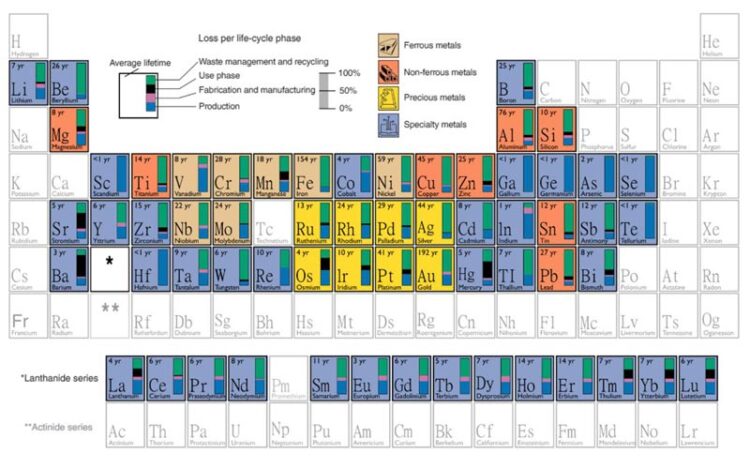Technology-specific raw materials show a short useful life in the life cycle assessment

Distribution of metal losses per life-cycle phase and average lifetimes of metals in the economy. © Nature Sustainability
A team of researchers from Bordeaux, Augsburg and Bayreuth has studied 61 different metals over the course of multiple years.
The results have been published in the prestigious journal “Nature Sustainability“ – The most significant finding was that the raw materials critical to modern technology, in particular, have a relatively short usage period.
How long are metallic and mineral raw materials usable in the economic cycle – and when do they dissipate? Researchers from Bordeaux, Augsburg, and Bayreuth, answer these questions about the life cycle of 61 metals in the high-ranking journal “Nature Sustainability.” Published and self-collected data on 61 metals were analyzed in research cooperation lasting several years. The most significant finding was that the raw materials critical to modern technology, in particular, have a relatively short usage period.
The availability of metals and minerals is essential for modern societies.
Using metals over long periods and in closed cycles secures the supply of raw materials for critical technologies. It also reduces material-related greenhouse gas emissions. For the first time, an international research group, with scientists from the Resource Lab of the University of Augsburg, has successfully quantified the losses of mineral resources for 61 metals in all phases of the material cycles.
The researcher found that iron and steel alloys have the longest usage period. “On average, these materials are available for 150 years due to high process efficiencies and good recycling rates”, explains Dr. Andrea Thorenz, head of the Resource Lab and co-author of the journal article. “Non-ferrous metals such as aluminum and copper and precious metals such as gold and silver still have more than 50 years. The large group of technology-specific metals, on the other hand, are only used for a decade on average. Therefore, new mining activities must continually compensate for the losses, leading to negative environmental impacts,” Thorenz sums up.
Based on data from the French geoscientific institute BRGM, it was possible to calculate how long metals are in use before they dissipate, meaning that they are so finely distributed that it is impossible to reuse them for economic or thermo-dynamic reasons.
“The joined research with colleagues from the University of Bordeaux and the University of Bayreuth make dissipative losses of metallic and mineral raw materials measurable and show a way to integrate them into the life cycle assessment,” says Dr. Thorenz. This achievement will improve the evaluation of the consumption of abiotic resources in the life cycle assessment.
Wissenschaftliche Ansprechpartner:
Dr. Andrea Thorenz
University of Augsburg
Senior Researcher, Head of Resource Lab
Institute of Materials Resource Management
Phone: +49 821 598-3948
Mail: andrea.thorenz@mrm.uni-augsburg.de
Originalpublikation:
https://www.nature.com/articles/s41893-022-00895-8.epdf?sharing_token=lL8vgkK_Rm…
https://www.uni-augsburg.de/de/campusleben/neuigkeiten/2022/05/20/6570/
Media Contact
All latest news from the category: Materials Sciences
Materials management deals with the research, development, manufacturing and processing of raw and industrial materials. Key aspects here are biological and medical issues, which play an increasingly important role in this field.
innovations-report offers in-depth articles related to the development and application of materials and the structure and properties of new materials.
Newest articles

Why getting in touch with our ‘gerbil brain’ could help machines listen better
Macquarie University researchers have debunked a 75-year-old theory about how humans determine where sounds are coming from, and it could unlock the secret to creating a next generation of more…

Attosecond core-level spectroscopy reveals real-time molecular dynamics
Chemical reactions are complex mechanisms. Many different dynamical processes are involved, affecting both the electrons and the nucleus of the present atoms. Very often the strongly coupled electron and nuclear…

Free-forming organelles help plants adapt to climate change
Scientists uncover how plants “see” shades of light, temperature. Plants’ ability to sense light and temperature, and their ability to adapt to climate change, hinges on free-forming structures in their…





















